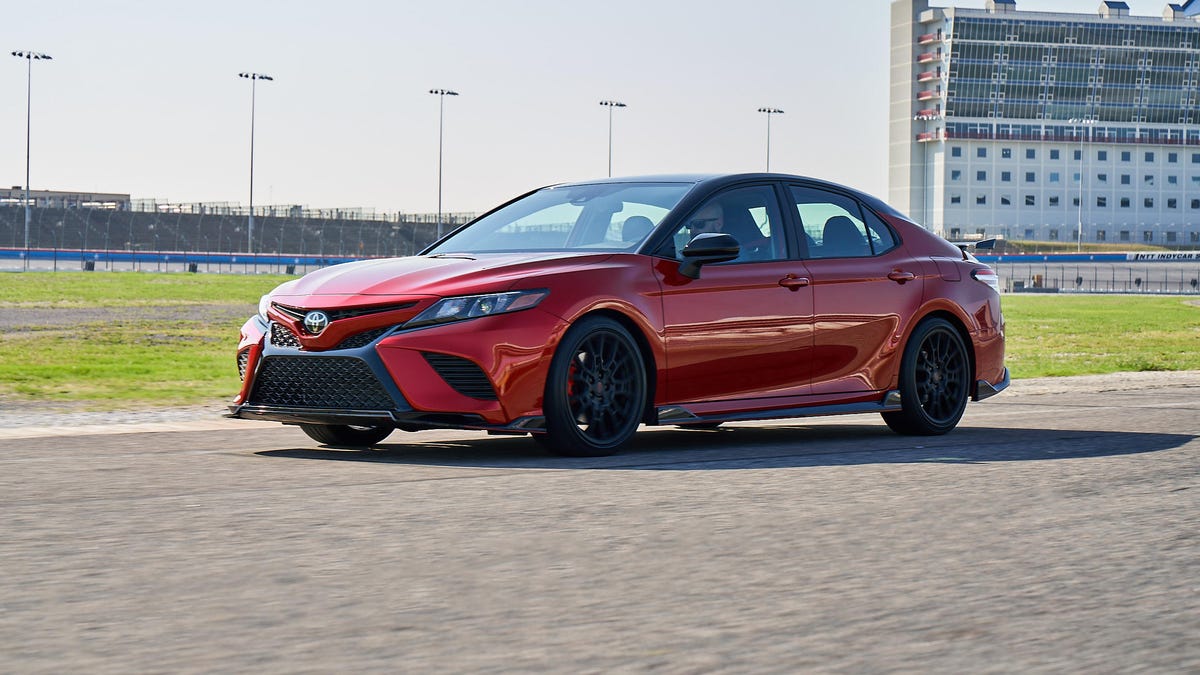2020 Toyota Camry and Avalon TRD first drive review: Snappy sedans
Toyota Racing Development gives the company's practical sedans improved handling chops and racier looks.
Toyota Racing Development came to the US in 1979 and is best known for dominating off-road motorsports in the 1980s and early 1990s. The company began offering performance parts and off-road packages for its production vehicles in 1997, and since then, TRD badges have adorned a number of Toyota products -- most recently, the 2020 Tacoma and 4Runner.
But this year, Toyota has been expanding TRD offerings to cars, as well. The company recently launched a TRD Edition of its zippy little 86 coupe, and for the 2020 model year, a similar performance upgrade is being given to the Camry and Avalon. Yes, two of the most family- and comfort-oriented sedans on the market are getting a TRD upgrade.
Maybe this isn't such a surprise, though. Consider this: The first TRD-spec car to ever compete in motorsports was a Toyota Crown sedan in the 1957 Mobilgas Rally Around Australia. More recently, TRD-tuned Camry race cars have seen podium finishes in the Monster Energy NASCAR Cup Series.
Both the Camry and Avalon get essentially the same TRD treatment. The sedans get stiffer coil springs and larger front and rear sway bars, making them far less roly-poly than their standard counterparts. Both cars get upgraded shocks, and the sedans are lowered by a little more than half an inch. Additional rigidity is achieved thanks to three new underbody braces, with the Camry going one step further thanks to an extra V-brace in the rear. Unfortunately, this means the rear seats are fixed, so the backrests don't fold down, limiting maximum cargo capacity. But considering this allows for a 44% increase in front stiffness and a 67% increase in rear stiffness versus a stock Camry, the tradeoff seems worth it to me. (Avalon numbers aren't available at the time of publishing.)
These TRD sedans both come with something Toyota calls Active Cornering Assist, a brake-based torque-vectoring system that slows the inside wheel in a corner to help the car rotate and turn-in more crisply. Speaking of wheels, the TRDs roll on 19-inch alloys, behind which you'll find 12.9-inch front rotors clamped by two-piston calipers. The rear brakes carry over from the standard models, with 12-inch rotors. The Camry rides on grippy Bridgestone Potenza summer tires while the Avalon makes do with Michelin Primacy all-season rubber. For both cars, the tires are half-an-inch wider than the stock setup. More contact area means more grip.
What TRD doesn't touch is the powertrain. Both cars use Toyota's well-regarded naturally aspirated, 3.5-liter V6, making 301 horsepower and 267 pound-feet of torque. Predictably, both models are mated to an eight-speed automatic transmission. TRD-specific cat-back exhausts add a bit more bass to the Camry and Avalon's engines' sound, but they don't actually result in any power increases.
On a short autocross course at Texas Motor Speedway set up by Toyota, the handling difference offered by the TRD models become obvious from I hit the first turn. Both the Camry and Avalon are much flatter while cornering, though there were times when the tires would still squeal in protest. Even during tight, fast corners, these sedans don't unsettle themselves, meaning it's possible to get back on the power sooner.
What I don't like is the eight-speed automatic transmission tuning. It upshifts far too early to actually allow me to eke out maximum power. I'd be less upset if the manual mode actually offered full manual control, but it doesn't: It panics and upshifts when the cars are driven aggressively, meaning I have to force a reactionary downshift. So annoying.
Both cars get an aero package that includes a new front splitter, side skirts, a rear diffuser and a rear spoiler -- the Camry's arguably being more tack-on-racer than the Avalon's. Inside, the TRD sedans get SofTex fabric on the seats and a smattering of red accent stitching. I like the interior updo, especially the vertical red stripe insets in the Camry's seats.
On the tech front, the TRD models have the same loadout as the standard versions. The Camry and Avalon come with Toyota's Safety Sense P suite of driver's aids, including full-speed adaptive cruise control, emergency forward braking, lane keeping assist and automatic high beams. The Avalon TRD goes not one, but two better by including blind-spot monitoring and rear cross traffic alert. Oddly, neither of these Advanced Driver Assist Systems are available on the Camry TRD.
Red accents are plentiful in both the Camry and Avalon TRD interiors.
Dashboard technology remains largely the same as well, although the Camry TRD adds Android Auto to its Apple CarPlay compatibility for 2020. The Avalon TRD makes do only with Apple CarPlay. Sorry, Google fans.
Toyota expects to produce 6,000 examples of the Camry TRD and only 2,600 of the Avalon TRD for 2020. Both models go on sale this month, with the Camry coming in at $31,040 and the Avalon at $42,300, not including destination. (In case you were wondering, that means the TRD is essentially the least expensive Camry model you can buy with a V6 engine.)
Do the handling upgrades turn the Toyotas into sports sedans worthy of competing with the segment's best? No. But for folks hoping their Camry (or Avalon) could be a little more, um, grounded to the ground, the upgraded chassis components are a welcome addition, and the higher-performance visuals will draw in more than a few fans, too.


